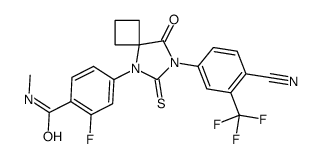915087-27-3
| Name | 4-[7-[4-cyano-3-(trifluoromethyl)phenyl]-8-oxo-6-sulfanylidene-5,7-diazaspiro[3.4]octan-5-yl]-2-fluoro-N-methylbenzamide |
|---|---|
| Synonyms |
4-[7-(4-cyano-3-trifluoromethyl-phenyl)-8-oxo-6-thioxo-5,7-diaza-spiro[3.4]oct-5-yl]-2-fluoro-n-methyl-benzamide
rd 162 N-Methyl-4-[7-(4-cyano-3-trifluoromethylphenyl)-8-oxo-6-thioxo-5,7-diazaspiro[3.4]octan-5-yl]-2-fluorobenzamide |
| Description | RD162, a diarylthiohydantoin, is an orally active non-steroidal antiandrogen (NSAA). RD162 specifically binds to androgen receptor (AR). RD162 induces tumor regression in mouse models of castration-resistant human prostate cancer[1]. |
|---|---|
| Related Catalog | |
| In Vitro | RD162 (1-10 μM; 4 days) suppresses growth and induces apoptosis in the human prostate cancer cell line VCaP which has endogenous AR gene amplification[1]. RD162 has little to no binding to the progesterone, estrogen or glucocorticoid receptors in an in vitro fluorescence polarization assay[1]. Cell Viability Assay[1] Cell Line: VCaP cells Concentration: 1, 10 μM Incubation Time: 4 days Result: Suppressed cell growth. |
| In Vivo | RD162 (10 mg/kg; oral gavage; daily; for 28 days) causes all tumors regressed[1]. RD162 (0.1, 1, 10 mg/kg; oral gavage; daily; for 5 days) consistently reduces luciferase activity with 10 mg/kg/day human LNCaP/AR xenografts grown in castrated male mice whereas lower doses of 0.1 and 1.0 mg/kg/day has minimal effect. RD162 substantially reduces cellular proliferation after 5 days[1]. RD162 (20 mg/kg; gavage) is ∼50 percent bioavailable after oral delivery with a serum half-life of about 30 hours[1]. Animal Model: Castrate male mice bearing LNCaP/AR xenografts[1] Dosage: 10 mg/kg Administration: Oral gavage; daily; for 28 days Result: Caused all tumors regressed. Animal Model: Male mice[1] Dosage: 20 mg/kg (Pharmacokinetic Analysis) Administration: Oral gavage (in 0.5% hydroxy-methyl-propyl-cellulose) Result: Had ∼50 percent bioavailable after oral delivery with a serum half-life of about 30 hours. |
| References |
| Density | 1.55 |
|---|---|
| Molecular Formula | C22H16F4N4O2S |
| Molecular Weight | 476.45 |
| Exact Mass | 476.09300 |
| PSA | 112.02000 |
| LogP | 4.84138 |
